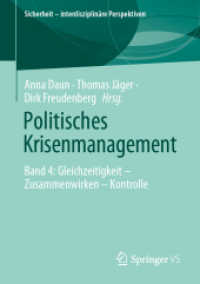- ホーム
- > 洋書
- > 英文書
- > Business / Economics
基本説明
Analyses the contribution of industrial relations to social science understanding.
Full Description
This collection aims to analyse, advertise, and criticize the contribution of industrial relations to social science understanding. It brings together leading scholars to reconsider the theoretical foundations of industrial relations and its potential contribution to the wider understanding of work and economic life, to learn what it can gain from a stronger engagement with these surrounding disciplines and national traditions.
The introduction provides a critical, though broadly sympathetic, outline of the development of the mainstream industrial relations tradition. Part One recognizes the interdisciplinary character of industrial relations by concentrating on 'border encounters' with the cognate academic disciplines of sociology, economics, management, history, psychology, law, politics, and geography. Of particular interest is how far industrial relations has contributed to social science understanding beyond its own narrow borders. Part Two combines a major critical analysis of the American school, with three shorter discussions of Australia, Europe, and Japan. Part Three looks forward to the potential contribution of industrial relations to our understanding of work, employment, and society by identifying a variety of key dilemmas and debates which call for new interdisciplinary thinking. Finally, the book ends with a critical reassessment of the industrial relations tradition.
Contents
PART I: DISCIPLINARY PERSPECTIVES ; PART II: COMPARATIVE PERSPECTIVES ; PART III: FUTURE DIRECTIONS: ISSUES AND ARGUMENTS








